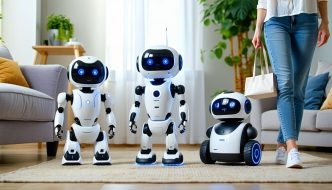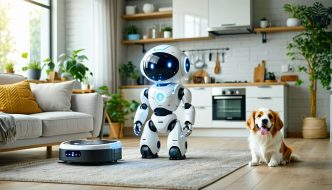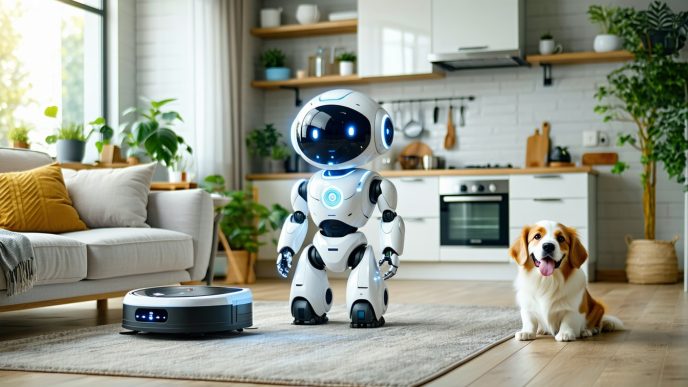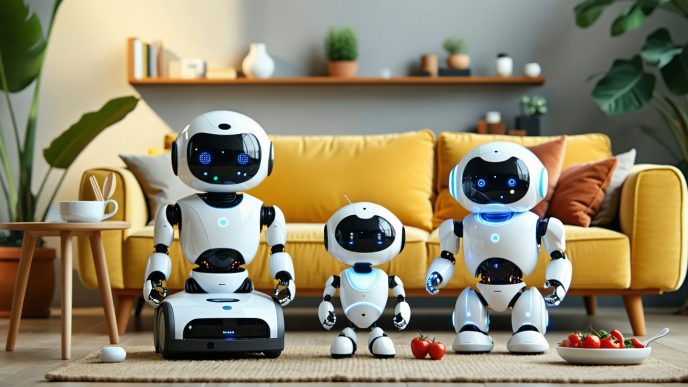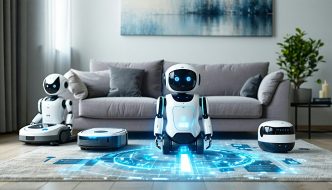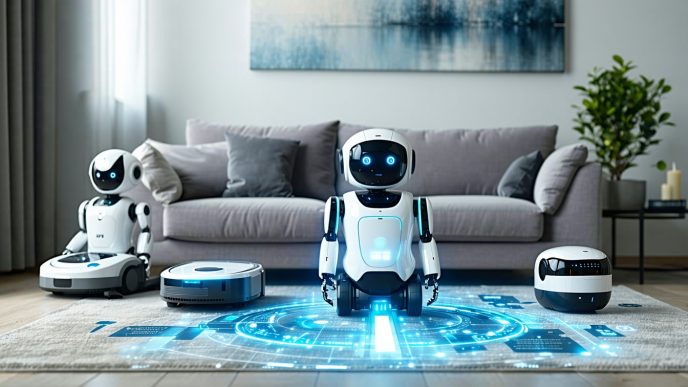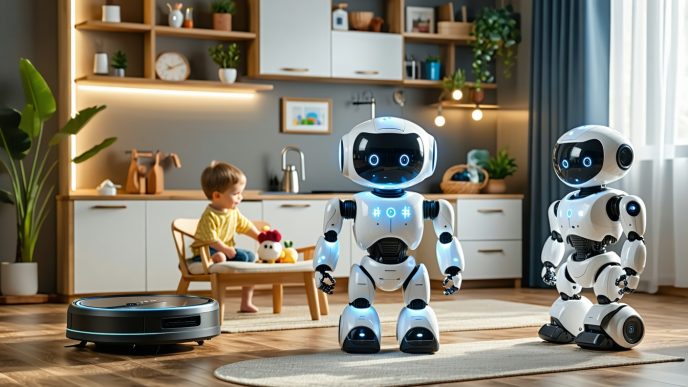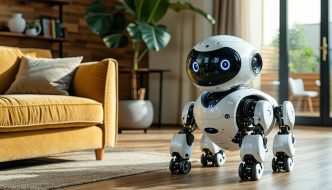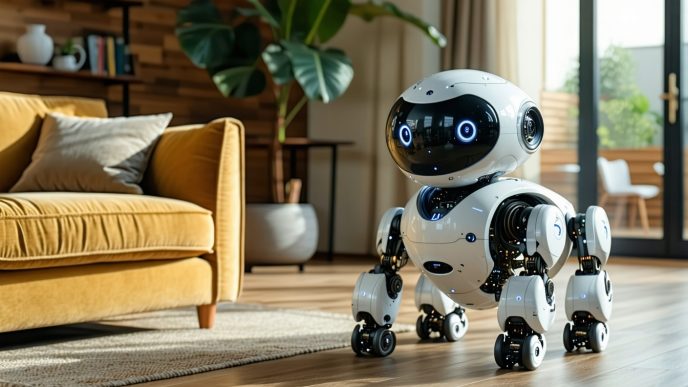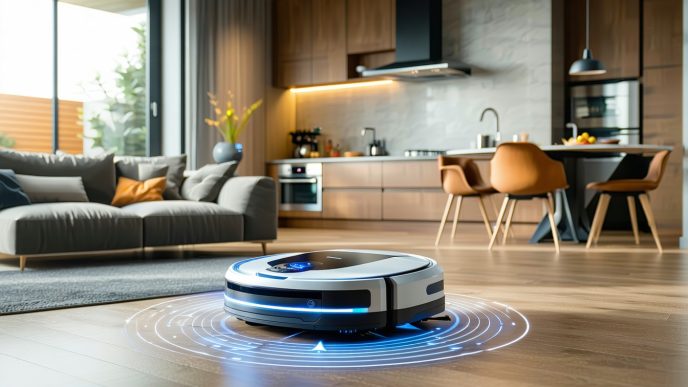Compact and Portable Robotics
In today’s world where living spaces are increasingly limited, the mobility of robots plays a crucial role in maximizing their functionality. Compact and portable robotics are designed to enhance convenience for users, especially those in apartments, condos, and small homes.
The Importance of Mobility in Robotics
Mobility in robotics allows for flexible usage in confined environments. Robots that can easily move and reposition themselves provide better utility and convenience. This is especially essential for tasks that require frequent transitions between different areas, making it easier for individuals to manage their living spaces efficiently.
Factors such as size, weight, and versatility contribute to making robots more portable. For instance, lightweight robots can be easily lifted and transported from one room to another. Compact designs enable users to house the robots without dedicating excessive space, a significant consideration for small-home enthusiasts. The following table summarizes the key attributes of mobility in compact robots.
| Attribute | Importance |
|---|---|
| Weight | Affects portability and ease of transport |
| Size | Determines storage capabilities and maneuverability |
| Versatility | Increases usability across various tasks |
| Functionality | Enhances overall efficiency in smaller living spaces |
Factors to Consider for Easy Transport and Repositioning
When selecting robots for compact spaces, certain factors must be considered. These elements ensure practicality and convenience in a limited environment.
-
Size and Weight: The ideal robot should be lightweight and easy to handle. A robot weighing less than 10 pounds is usually manageable for repositioning.
-
Folding or Compact Design: Robots that can be folded or have a compact structure are easier to store and move around. This feature is especially advantageous when space is at a premium.
-
Maneuverability: The ability to turn and navigate easily in tight spaces can significantly enhance a robot’s usefulness. Equipped with wheels or pivoting capabilities, robots can efficiently maneuver around furniture and obstacles.
-
Storage Options: Users should consider robots that come with their own storage solutions, allowing for a streamlined experience when not in use.
-
Durability: Robust materials contribute to prolonged usability, ensuring that the robot can withstand routine movement and handling.
Reviewing these factors can significantly influence the decision-making process when searching for the best lightweight robots for easy transport. Individuals looking to enhance their living conditions with robotics will find that the right selection can lead to improved quality of life in smaller homes. For additional tips on making the most of robotics in such environments, explore our guidelines on tips for using robots in small homes.
Robot Types for Small Spaces
For those living in apartments, condos, or other small homes, finding robots that maximize functionality while occupying minimal space is crucial. This section highlights two popular categories of robots that are well-suited for small environments: lightweight cleaning robots and portable personal assistant robots.
Lightweight Cleaning Robots
Lightweight cleaning robots are designed for efficient cleaning in compact spaces. These robots are often small in size, making them ideal for maneuvering in tighter areas such as narrow hallways and under furniture.
Many of these cleaning robots come equipped with smart navigation systems that ensure they can effectively map small spaces and cover essential cleaning areas. Various models may include features such as automatic dirt detection and scheduling capabilities.
Here’s a table showcasing key attributes of some lightweight cleaning robots suitable for small homes:
| Robot Model | Weight (lbs) | Battery Life (mins) | Coverage Area (sq ft) |
|---|---|---|---|
| Model A | 5 | 90 | 1000 |
| Model B | 6 | 60 | 800 |
| Model C | 4 | 75 | 600 |
For a comprehensive look at various cleaning robots, refer to our article on best small cleaning robots.
Portable Personal Assistant Robots
Portable personal assistant robots serve to simplify daily tasks in small homes. These robots can perform functions such as providing information, managing schedules, and even assisting with home automation. Their compact size allows them to fit comfortably on countertops or small tables, ensuring they remain accessible without taking up much space.
Many personal assistant robots also feature voice recognition and can integrate with various smart home devices, streamlining interactions within small living environments. Their lightweight nature allows for easy transport from one room to another without hassle.
The following table outlines key specifications of some portable personal assistant robots:
| Robot Model | Weight (lbs) | Connectivity | Voice Recognition |
|---|---|---|---|
| Model D | 3 | Wi-Fi, Bluetooth | Yes |
| Model E | 4 | Wi-Fi | Yes |
| Model F | 3.5 | Bluetooth | Yes |
For more detailed analyses of personal assistant robots designed for small living spaces, check our article on best home assistant robots for small homes.
The growing popularity of lightweight cleaning robots and portable personal assistant robots signifies a move towards efficient, compact living solutions. For additional tips regarding the use of robots in small homes, refer to our guide on tips for using robots in small homes.
Characteristics to Look for
When selecting a robot for small homes, certain characteristics are essential for ensuring ease of transport and repositioning. These factors will help apartment dwellers, condo owners, renters, and small-home enthusiasts find the best lightweight robots for easy transport.
Size and Weight
The size and weight of a robot play critical roles in its portability and functionality within compact living spaces. Here’s a quick comparison that highlights the typical size and weight categories for small home robots:
| Robot Type | Average Size (inches) | Average Weight (lbs) |
|---|---|---|
| Lightweight Cleaning Robots | 12 x 12 | 5-10 |
| Personal Assistant Robots | 15 x 9 | 7-12 |
| Humanoid Robots | 24 x 12 | 10-20 |
Choosing robots with a weight under 10 pounds is ideal for easy transport. Opting for those with a smaller footprint ensures they can navigate tight spaces effectively.
Folding or Compact Design
A folding or compact design enhances storage options and makes repositioning easier. Robots that can collapse or adjust in size allow for effective use of available space. Features to consider include:
- Folding Mechanisms: Robots that can be folded for storage are easier to manage.
- Compact Profiles: Low-profile designs can fit under furniture or in closets without taking up significant space.
For robotics that suit small homes, checking out the best compact humanoid robots or best small quadruped robots can provide valuable insights into compact design options.
Easy Storage and Maneuverability
Efficient storage solutions and the ability to maneuver around obstacles are vital for maximizing a robot’s utility in small homes. Consider these features:
- Storage Solutions: Look for robots with designated storage compartments or cases that simplify organization.
- Wheels and Movement: Smoothly rolling wheels can enhance maneuverability, making it easier to reposition around furniture and tight corners.
A table summarizing storage and maneuverability features can help illustrate different robot capabilities:
| Robot Type | Storage Feature | Maneuverability Rating (1-5) |
|---|---|---|
| Lightweight Cleaning Robots | Compact storage bag | 4 |
| Personal Assistant Robots | Built-in storage | 3 |
| Home Assistant Robots | Foldable design | 5 |
Robots that excel in storage and maneuverability are often highlighted in discussions on best robots with smart navigation for small spaces or best home assistant robots for small homes. Evaluating these characteristics can greatly enhance the functionality and ease of use of robots in compact living environments.
Ease of Repositioning
In small living spaces, the ease of repositioning robots is critical for ensuring effective functionality. Key features that enhance mobility are swivel and rotation capabilities, smooth movement and control features, and adaptive navigation systems.
Swivel and Rotation Capabilities
Swivel and rotation capabilities allow robots to maneuver effectively in tight spaces. The ability to rotate on the spot makes repositioning simple and efficient. Robots equipped with these features can navigate around furniture and obstacles without needing extensive linear space.
| Robot Type | Swivel Capability | Rotation Angle |
|---|---|---|
| Cleaning Robots | Yes | 360° |
| Personal Assistants | Yes | 180° |
| Quadruped Robots | Yes | 360° |
These features are particularly beneficial for apartment dwellers who need robots that adapt to their limited environments. Robots with advanced swivel mechanisms can simplify tasks like cleaning and monitoring.
Smooth Movement and Control Features
For a seamless experience, robots should possess smooth movement and responsive control features. Incorporating advanced sensors and precision wheels enhances their ability to traverse various surfaces without difficulty. Smooth motion reduces the risk of damage to both the robot and surrounding items.
| Control Feature | Description |
|---|---|
| Sensor Technology | Enables precise obstacle detection and avoidance |
| Speed Settings | Allows for adjustments based on environment |
| Wheel Design | Enhances surface grip and mobility |
With these capabilities, robots can easily navigate from room to room, making them ideal for small homes. Robotics designed with these control features cater to the need for efficiency in compact spaces.
Adaptive Navigation Systems
Adaptive navigation systems are essential for robots operating in small areas. These systems utilize complex algorithms and mapping technologies to create an optimal path while avoiding obstacles. This ensures consistent performance in dynamic environments, such as apartments or condos.
| Navigation System Type | Key Features |
|---|---|
| Lidar Navigation | Creates detailed 3D maps and identifies obstacles |
| Visual Recognition | Uses cameras to interpret and adapt to surroundings |
| Machine Learning | Improves navigation based on user habits over time |
These advanced systems enhance the user experience by allowing robots to perform tasks autonomously and efficiently. For those seeking the best lightweight robots for easy transport, understanding these navigation capabilities is vital. Exploring innovations in this field can further enhance the functionality of robots in small living spaces.
Simplifying Robot Maintenance
When considering the best lightweight robots for easy transport, maintenance is a key factor. Easy access for cleaning and maintenance, along with the ability to replace parts without hassle, enhances the overall user experience, especially for individuals living in smaller spaces.
Accessibility for Cleaning and Maintenance
Robots with designs that allow easy access to essential components simplify the cleaning and maintenance process. This is particularly beneficial in small homes where efficiency is critical.
| Feature | Importance |
|---|---|
| Accessible Design | Allows users to clean filters and sensors without difficulty |
| User-Friendly Instructions | Clear guidelines for maintenance steps enhance user experience |
| Maintenance Alerts | Some robots provide notifications when maintenance is required, preventing issues from escalating |
Many compact robots incorporate compartments that can be opened easily, allowing for straightforward cleaning of dust bins and brushes. Regular maintenance ensures that the robots function optimally, providing effective assistance in smaller living areas.
Easily Replaceable Parts
Robots designed for compact living should ideally have components that are easy to replace. Quick and simple replacement can save time and money, ensuring that the robot can continue to operate efficiently.
| Component | Replacement Ease |
|---|---|
| Filters | Typically simple to remove and replace |
| Brushes | Often designed for quick detachment, facilitating easy upkeep |
| Batteries | Should be easy to access for replacement without extensive disassembly |
Many models feature modular designs, where components can be swapped out without technical skills. This benefit is significant for apartment dwellers and renters who seek robots that are low-maintenance yet effective. For more information on selecting the best robots for small homes, check out our article on best robots for small homes.
Maintaining robots effectively not only ensures longevity but also enhances the quality of home assistance. An accessible and easy-to-maintain robot becomes a reliable companion tailored for small living spaces. For additional guidance on optimizing robot usage, visit our article on tips for using robots in small homes.
Future of Mobile Robotics
The field of mobile robotics is rapidly evolving, focusing on creating devices that are not only functional but also suitable for small living spaces. As technology advances, new possibilities emerge that enhance the mobility and efficiency of robots designed for compact environments.
Advances in Mobility Technology
Recent innovations in mobility technology have opened up new avenues for creating lightweight and portable robots. These advancements include improved battery efficiency, which allows robots to operate longer without needing a recharge. Enhanced power management systems ensure optimal performance while minimizing weight, making robots easier to transport.
Additionally, innovations in wheel and leg design contribute to smoother movement over various surfaces. For instance, robots equipped with omnidirectional wheels can maneuver seamlessly in tight spaces, while small quadruped robots can traverse uneven terrain with ease. The following table highlights some key features of current mobility technologies:
| Mobility Technology | Description | Benefits |
|---|---|---|
| Omnidirectional Wheels | Allows movement in any direction effortlessly | Improved maneuverability in tight spaces |
| Advanced Battery Systems | Longer operation times with less weight | Reduced need for frequent recharges |
| Enhanced Leg Mechanisms | Capable of traversing various surfaces | Increased versatility across environments |
Potential Innovations in Transportable Robots
Looking ahead, the potential for innovations in transportable robots is significant. Future designs may incorporate features such as self-folding mechanisms that reduce size for storage or portable docking stations that ease recharging and maintenance.
Furthermore, advancements in artificial intelligence (AI) will enable better adaptive navigation systems. These systems could allow robots to learn and adapt to the layout of a small home, optimizing their performance and preventing obstructions. For example, robots could fine-tune their cleaning paths based on real-time data, providing more efficient service in limited spaces.
Developments in materials science may also lead to lighter and sturdier construction, making robots easier to carry without sacrificing durability. Compact humanoid robots and home assistant robots are likely to be at the forefront of these innovations, ensuring they fit seamlessly into modern small homes. For further insights, explore our articles on best compact humanoid robots and best home assistant robots for small homes.
As the future of mobile robotics unfolds, apartment dwellers and small-home enthusiasts can anticipate a new wave of lightweight robots optimized for easy transport and efficient performance in their spaces.

